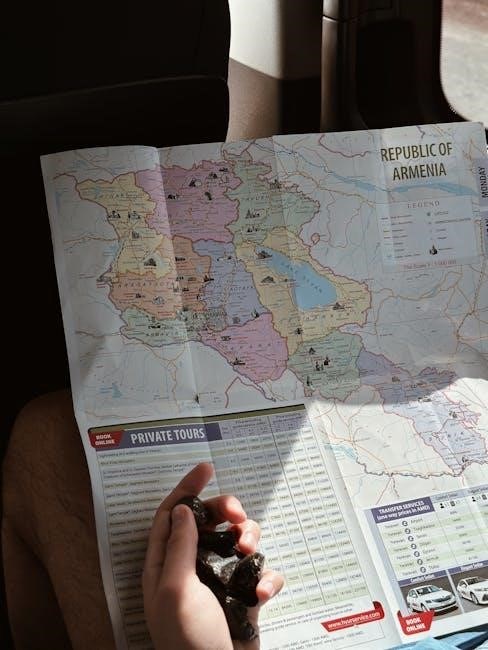Discover the best of San Francisco with our detailed map, featuring iconic landmarks, hidden gems, and practical tips for an unforgettable journey through this vibrant city.
Overview of the Map’s Features and Benefits
The San Francisco Tour Guide Map is a comprehensive tool designed to enhance your exploration of the city. It features high-resolution details of iconic landmarks, neighborhoods, and hidden gems, ensuring you don’t miss any must-see attractions. The map is free, downloadable in PDF format, and printable, making it easily accessible for planning your trip. It highlights popular locations, such as the Golden Gate Bridge, Fisherman’s Wharf, and Chinatown, while also providing insights into cultural and historical points of interest. Additionally, the map includes suggested itineraries and practical tips for navigating the city, helping you make the most of your visit. Whether you’re a first-time visitor or a seasoned traveler, this map is an essential resource for discovering San Francisco’s diverse offerings.
Why Use a Tour Guide Map for San Francisco?
A San Francisco Tour Guide Map is an essential resource for navigating the city’s vibrant neighborhoods, iconic landmarks, and hidden gems. It offers a convenient and comprehensive way to plan your trip, ensuring you don’t miss out on must-see attractions. The map is free, downloadable, and printable, making it easily accessible for travelers. It provides high-resolution details of popular locations, such as the Golden Gate Bridge and Fisherman’s Wharf, while also highlighting lesser-known spots. Additionally, it includes suggested itineraries and practical tips for getting around, dining, and shopping. Whether you’re exploring historic sites, cultural hotspots, or outdoor activities, the map serves as a customizable guide tailored to your interests, helping you make the most of your San Francisco experience.

Popular Attractions and Landmarks
San Francisco’s iconic landmarks, such as the Golden Gate Bridge, Alcatraz Island, and Union Square, attract millions of visitors. Explore Lombard Street and Fisherman’s Wharf for unforgettable experiences.
Must-See Landmarks in San Francisco
San Francisco is home to iconic landmarks that define its character. The Golden Gate Bridge, an engineering marvel, offers breathtaking views of the bay. Alcatraz Island, a former prison turned national park, provides a glimpse into history. Union Square is a vibrant hub for shopping and dining. The Golden Gate Park features stunning gardens and museums, while Lombard Street, known as the “crookedest street,” captivates visitors. Fisherman’s Wharf is perfect for seafood and street performances. The San Francisco Skyline, with the towering Salesforce Tower, is a modern marvel. Don’t miss the Painted Ladies, colorful Victorian homes, and the Ferry Building, a historic landmark with a bustling market. These landmarks showcase the city’s diverse charm and are essential for any visitor’s itinerary.
Iconic Neighborhoods to Explore
San Francisco’s iconic neighborhoods offer a diverse cultural and historical experience. Haight-Ashbury, famous for its 1960s hippie movement, is a hub for vintage shops and bohemian vibes. Fisherman’s Wharf and the Waterfront provide stunning bay views, fresh seafood, and lively street performers. North Beach, San Francisco’s Italian district, is known for its charming cafes, bakeries, and the Beat Generation’s history. Chinatown, one of the largest outside Asia, offers vibrant streets, authentic cuisine, and unique shops. The Mission District is a kaleidoscope of Latin American culture, street art, and mouthwatering food. Pacific Heights boasts luxury homes and panoramic views of the city. Each neighborhood tells a unique story, making San Francisco a city of endless discovery and cultural richness.
Hidden Gems Off the Beaten Path
San Francisco is full of hidden gems waiting to be discovered. One such gem is the 16th Avenue Tiled Steps, a vibrant mosaic staircase in the Inner Sunset neighborhood that’s often overlooked by tourists. Another is the Alemany Farmers Market, a local favorite that offers fresh produce and a taste of authentic San Francisco culture. For nature lovers, the Wave Organ on the waterfront is a unique acoustic sculpture that uses wave movements to create sound. The Sutro Baths, a ruins site near the Golden Gate, provides a peaceful retreat with stunning ocean views. These lesser-known spots offer a chance to experience the city’s diverse culture, history, and natural beauty without the crowds, making them perfect for adventurous explorers seeking something beyond the usual attractions.
Cultural and Historical Points of Interest
San Francisco is a treasure trove of cultural and historical significance, offering a wealth of sites that showcase its rich heritage. The de Young Museum and the California Palace of the Legion of Honor are must-visits for art and history enthusiasts, featuring extensive collections from around the world. Mission Dolores, the oldest surviving structure in San Francisco, provides a glimpse into the city’s founding and its Spanish colonial past. The Presidio, a former military base turned national park, offers historic sites, museums, and breathtaking views. Additionally, the San Francisco Museum of Modern Art (SFMOMA) highlights modern and contemporary art, while the historic ships at Pier 45, such as the USS Pampanito and SS Jeremiah O’Brien, offer a deep dive into the city’s maritime history. These cultural and historical points of interest make San Francisco a fascinating destination for learners and explorers alike.

Detailed Maps for Specific Areas
The San Francisco tour guide map offers detailed maps for specific areas like Downtown, Golden Gate Park, and Fisherman’s Wharf, providing street views, attractions, and transit information.
Downtown San Francisco Map
Downtown San Francisco is the bustling heart of the city, featuring iconic landmarks like Union Square and the Financial District. The detailed map highlights key attractions, such as shopping centers, theaters, and historic buildings. It also pinpoints public transportation hubs, including BART and Muni Metro stations, making it easy to navigate. The map showcases nearby gems like the Embarcadero and Ferry Building, offering stunning Bay Bridge views. Whether you’re exploring corporate offices, cultural venues, or vibrant nightlife, this section provides a comprehensive guide to the area’s layout and highlights. Use it to plan efficient routes and discover hidden spots amidst the urban hustle.
Golden Gate Park and Surroundings
Golden Gate Park is a sprawling urban oasis, offering a mix of natural beauty, cultural attractions, and recreational opportunities. The map details the park’s layout, highlighting key spots like the Japanese Tea Garden, California Academy of Sciences, and de Young Museum. It also marks picnic areas, biking paths, and lakes. Surrounding neighborhoods, such as Haight-Ashbury, are included, showcasing their vibrant shops and historic significance. The map helps visitors navigate the park’s vast grounds and explore its diverse offerings. Whether you’re interested in nature, art, or history, this section provides a clear guide to making the most of your visit to Golden Gate Park and its charming surroundings.
Fisherman’s Wharf and the Waterfront
Fisherman’s Wharf is one of San Francisco’s most iconic destinations, offering stunning waterfront views, fresh seafood, and lively street performers. The map highlights key attractions like Pier 39, famous for its resident sea lions, and the historic fishing piers. It also marks popular eateries, souvenir shops, and boat tour departure points. The waterfront area is perfect for a leisurely stroll, with clear pathways and scenic overlooks to enjoy the bay and Golden Gate Bridge vistas. Practical information, such as parking lots and public transit options, is included to help visitors navigate the area effortlessly. Whether you’re looking to dine, shop, or simply soak in the atmosphere, this section ensures you make the most of your visit to Fisherman’s Wharf and its picturesque surroundings.
Haight-Ashbury and the Mission District
Haight-Ashbury, famously known as the epicenter of the 1960s counterculture movement, offers a vibrant mix of vintage shops, record stores, and murals celebrating its hippie history. The map highlights iconic spots like the “Painted Ladies” Victorian houses and the Red Victorian Bed & Breakfast, a relic of the Summer of Love. Nearby, the Mission District is a hotspot for Latinx culture, street art, and diverse cuisine. The map points out popular eateries serving authentic Mission-style burritos and highlights vibrant murals along Clarion Alley. Practical tips guide visitors through the best ways to explore these neighborhoods, whether by public transit or on foot. Together, these areas provide a rich blend of history, culture, and creativity, making them a must-explore for any San Francisco visitor.
Chinatown and North Beach
San Francisco’s Chinatown is one of the largest and most vibrant outside Asia, offering a rich cultural experience. The map highlights iconic landmarks like the Dragon’s Gate at Grant Avenue, colorful temples, and bustling streets filled with markets and eateries. Visitors can explore authentic dim sum restaurants, tea shops, and unique souvenir stores. Just nearby, North Beach is the city’s historic Italian district, known for its charming atmosphere, cozy cafes, and beautiful churches like St. Peter and Paul Church. The map also points out the famous City Lights Bookstore, a hub of the Beat Generation, and recommends iconic spots like Caffe Trieste for a traditional Italian espresso. Both neighborhoods offer a blend of history, culture, and cuisine, making them a must-visit for any San Francisco traveler.

Itinerary Suggestions
Discover tailored itineraries for exploring San Francisco’s diverse neighborhoods, cultural attractions, and scenic beauty, ensuring a memorable and well-organized trip for every traveler;
1-Day Itinerary for First-Time Visitors
Start your day with a visit to the iconic
3-Day Itinerary for a Comprehensive Tour
Embark on a 3-day journey to explore San Francisco’s vibrant culture, iconic landmarks, and hidden treasures. Day 1: Begin with the Golden Gate Bridge, then visit Alcatraz Island for a fascinating historical tour. After lunch, wander through Fisherman’s Wharf and Pier 39, where sea lions and street performers await. End the day with a scenic drive to the top of Lombard Street for stunning city views.

Day 2: Dive into nature and art at Golden Gate Park. Visit the Japanese Tea Garden and the de Young Museum. Afterward, head to Haight-Ashbury for a nostalgic glimpse of the 1960s counterculture. Conclude the day with dinner in the Mission District, where vibrant murals and authentic Mexican cuisine thrive.
Day 3: Immerse yourself in local life. Explore Chinatown’s colorful streets and shops, then stroll through North Beach for Italian flavors. Visit the Ferry Building Marketplace for fresh produce and artisanal goods. Finally, relax at Dolores Park or catch a sunset at the Fillmore, a legendary music venue. This itinerary offers a balanced mix of famous attractions and local favorites, ensuring a memorable San Francisco experience.
Family-Friendly Itinerary
Plan a fun-filled, family-friendly tour of San Francisco with activities suitable for all ages. Start your day at the California Academy of Sciences, where interactive exhibits and a planetarium captivate kids. Next, head to Golden Gate Park for a picnic and exploration of its playgrounds and gardens. After lunch, visit the Exploratorium, a hands-on science museum that sparks curiosity; End the day with a scenic cable car ride to enjoy breathtaking city views. For younger children, consider a stop at the San Francisco Zoo or a boat ride at Stow Lake in Golden Gate Park. This itinerary balances education, adventure, and relaxation, ensuring a memorable experience for families visiting San Francisco.
Food and Wine Lovers’ Itinerary
Indulge in San Francisco’s vibrant culinary scene with a tailored itinerary for food and wine enthusiasts. Begin your day at the Ferry Building Farmers Market, where local produce, artisanal cheeses, and fresh seafood await. Next, explore North Beach, San Francisco’s historic Italian quarter, and enjoy authentic pasta dishes at beloved eateries like Zuni Cafe. For a midday treat, head to Fisherman’s Wharf and savor fresh Dungeness crab or cioppino, a San Francisco classic. In the afternoon, visit State Bird Provisions for creative, farm-to-table small plates. End your day with a wine tasting at The Press Club, featuring selections from nearby Napa and Sonoma. This itinerary highlights the city’s iconic flavors and hidden culinary gems, offering a delicious journey through San Francisco’s food and wine culture.
Adventure and Outdoor Activities Itinerary
Embark on an action-packed adventure in San Francisco, exploring its stunning outdoor landscapes and thrilling activities. Start your day with a hike through Golden Gate Park, where trails wind through lush gardens and iconic landmarks like the Japanese Tea Garden. Next, bike across the Golden Gate Bridge for breathtaking views of the bay and Alcatraz Island. Stop at Crissy Field for a picnic with panoramic vistas; In the afternoon, head to Muir Woods National Monument to hike among towering redwoods. End your day with a sunset walk along the Lands End Coastal Trail, offering dramatic ocean views. For the more daring, consider a kayaking trip on the bay or a rock-climbing session at Bernal Heights. This itinerary combines nature, adventure, and iconic San Francisco experiences for the ultimate outdoor enthusiast.

Additional Resources
Discover a variety of tools to enhance your San Francisco experience, including free printable maps, interactive online guides, and comprehensive visitor planning tools for easy navigation.
- Free Printable Maps
- Interactive Online Maps
- AAA Destination Guide
- Visitor’s Guide with Planning Tools
Free Printable and Downloadable Maps
Access a wide range of free printable and downloadable maps tailored for exploring San Francisco. These resources are perfect for planning your trip offline and on the go. Available in formats like PDF, these maps can be easily downloaded from official tourism websites or picked up at local visitor centers. Many maps include customizable itineraries, highlighting must-see attractions, public transportation routes, and dining hotspots. High-resolution versions ensure clarity, while foldable designs make them convenient for carrying. Discover maps focused on specific interests, such as walking tours, bike paths, or food trails. Whether you’re navigating the Golden Gate Bridge area or exploring Fisherman’s Wharf, these maps provide essential details to enhance your San Francisco adventure. Download your preferred map today and start planning the perfect trip!
- Customizable itineraries for different interests
- Public transportation and bike route details
- High-resolution, foldable designs
- Available in multiple formats (PDF, etc.)
- Covers popular attractions and hidden gems
Download your San Francisco map now and make the most of your visit!
Interactive Online Maps for Real-Time Navigation
Enhance your San Francisco experience with interactive online maps designed for real-time navigation; These dynamic tools provide up-to-date information, allowing you to explore the city seamlessly. GPS-enabled maps offer turn-by-turn directions, while real-time traffic updates help you avoid congestion. Many platforms include layers for points of interest, public transportation, and walking routes. Customizable filters let you focus on specific attractions, dining options, or shopping areas. Popular services like Google Maps and Citymapper integrate additional features such as bike-sharing locations and event schedules. Access these maps on your smartphone or tablet for instant guidance. Offline modes ensure navigation even without internet access, making them indispensable for travelers. With interactive maps, you can discover hidden gems and optimize your itinerary efficiently.
- GPS-enabled navigation with real-time traffic updates
- Customizable filters for attractions and activities
- Integration with public transit and bike-sharing
- Offline access for areas with limited connectivity
- Compatibility with smartphones and tablets
Explore San Francisco like a local with these intuitive and user-friendly tools!

AAA Destination Guide for San Francisco
The AAA Destination Guide for San Francisco is a trusted resource for travelers, offering detailed insights into the city’s top attractions, dining options, and accommodations. Designed to help visitors make the most of their trip, this guide provides expert recommendations, maps, and tips tailored to different interests and preferences. It includes ratings for hotels, restaurants, and points of interest, ensuring travelers can make informed decisions. The guide also features itineraries and suggestions for exploring San Francisco’s diverse neighborhoods, cultural landmarks, and outdoor activities. With practical advice on transportation, safety, and seasonal events, the AAA Guide is an essential companion for both first-time visitors and seasoned travelers. Use it to discover hidden gems and plan a memorable journey through one of America’s most vibrant cities.
- Detailed recommendations for attractions and activities
- Expert ratings for hotels, restaurants, and points of interest
- Custom itineraries based on traveler preferences
- Practical tips for transportation and safety
- Insights into cultural landmarks and outdoor activities
Plan your trip with confidence using the AAA Destination Guide for San Francisco!

Visitor’s Guide with Planning Tools
The Visitor’s Guide with Planning Tools is a comprehensive resource designed to help travelers organize their San Francisco adventure. It includes interactive maps, customizable itineraries, and checklists to ensure no detail is overlooked. This guide is perfect for both first-time visitors and experienced travelers, offering tips to maximize your time and enhance your experience. With features like attraction opening hours, ticket options, and transportation advice, it simplifies trip planning. Additionally, it provides recommendations for dining, accommodations, and shopping, catering to various budgets and preferences. The guide also highlights seasonal events and festivals, ensuring you don’t miss out on unique experiences. Use the Visitor’s Guide to create a personalized plan that suits your interests and makes your San Francisco trip unforgettable;
- Customizable itineraries for different interests
- Practical tips for dining, shopping, and accommodations
- Insights into seasonal events and festivals
- Interactive maps for easy navigation
- Checklists to stay organized
Plan your San Francisco adventure with ease using this essential guide!

Practical Tips for Using the Map
Start by orienting yourself with major landmarks and symbols. Use public transport options like Muni Metro or buses for efficient navigation. Plan your route to minimize walking distances. Highlight popular attractions and hidden gems based on your interests. Regularly update your map for seasonal changes or event closures. Mark personal preferences like dining spots or shops. Adjust your itinerary according to opening hours and ticket requirements. Always carry a physical copy as a backup. Familiarize yourself with neighborhood layouts to avoid getting lost. Use the map’s scale to estimate travel times accurately. Stay organized and enjoy exploring San Francisco seamlessly!
Key tip: Customize your map to suit your travel style and preferences for the best experience.
How to Get Around San Francisco
San Francisco offers a variety of transportation options to suit every traveler’s needs. The Muni Metro and buses provide an affordable and extensive network, while cable cars offer a historic way to explore popular areas. For convenience, ride-hailing services like Uber and Lyft are widely available. Walking is ideal for shorter distances, especially in iconic neighborhoods like Fisherman’s Wharf or Haight-Ashbury. Biking is another great option, with rental services such as Ford GoBike scattered throughout the city. If driving, be prepared for steep hills and limited parking. Use the map to plan your route efficiently and consider purchasing a Clipper card for seamless travel on public transit. Real-time navigation apps can also help optimize your journey. Plan ahead to avoid rush-hour delays and make the most of your time exploring the city.
TIP: Combine public transit with walking for a balanced and cost-effective way to experience San Francisco.
Best Times to Visit Major Attractions
Planning your visits to San Francisco’s major attractions during the right times can enhance your experience. For iconic spots like the Golden Gate Bridge or Alcatraz Island, consider visiting early in the morning or late in the afternoon to avoid crowds. Popular areas like Fisherman’s Wharf and Pier 39 tend to be busiest during midday, especially on weekends. If you’re exploring museums such as the de Young or the Exploratorium, weekdays are ideal for shorter wait times. Seasonal variations also play a role; summer attracts larger crowds, while spring and fall offer milder weather and smaller groups. Use the tour guide map to identify peak hours for attractions and plan your itinerary accordingly. Booking tickets in advance for popular sites like Alcatraz can save time and ensure availability.
TIP: Weekday mornings are often the best time to explore major landmarks without the hustle and bustle of crowds.
Where to Eat and Drink
San Francisco is a culinary paradise, offering a diverse range of dining options to suit every palate and budget. For fresh seafood, head to Fisherman’s Wharf, where restaurants like Alioto’s serve up iconic dishes. Chinatown is a must-visit for authentic dim sum and noodles, while the Mission District is famous for its vibrant taco trucks and Mexican eateries. North Beach, with its Italian roots, boasts cozy cafes and pizzerias like Tony’s Pizza Napoletana. The Ferry Building Farmers Market is a great spot for artisanal foods and local wines. Don’t miss the charming bakeries in Haight-Ashbury or the upscale dining options in SoMa. Use the tour guide map to discover hidden gems, from cozy cafes to Michelin-starred restaurants, ensuring a memorable culinary experience.
TIP: Make reservations in advance for popular spots, especially during peak travel seasons.
Shopping Areas and Local Markets
San Francisco offers a variety of shopping experiences, from high-end boutiques to vibrant local markets. Union Square is a hub for luxury shopping, featuring department stores like Macy’s and Saks Fifth Avenue, as well as boutique flagships. For unique finds, explore Haight-Ashbury’s vintage shops and Fillmore Street’s designer brands. The Ferry Building Farmers Market is perfect for artisanal goods, fresh produce, and local crafts. Hayes Valley combines trendy boutiques with art galleries, offering a curated shopping experience. Use the tour guide map to navigate these districts and discover hidden gems. Whether you’re looking for designer fashion, handmade items, or souvenirs, San Francisco’s diverse shopping scene has something for everyone;
TIP: Visit local markets on weekends for a wider selection of vendors and live entertainment.
Seasonal Events and Festivals
San Francisco’s vibrant calendar is packed with seasonal events and festivals that showcase its diverse culture and spirit. The Cherry Blossom Festival in April transforms Japantown with pink blooms and traditional celebrations. June brings the iconic Pride Parade, one of the world’s largest LGBTQ+ events. In August, the Outside Lands Music Festival in Golden Gate Park features top artists and gourmet food. The Fleet Week in October highlights naval displays and airshows, while the Union Square Christmas Tree Lighting in November kicks off the holiday season. Use the tour guide map to locate festival venues and plan your visit around these events. Each festival offers a unique way to experience the city’s energy and traditions.
Check the map for event-specific transit options and crowd tips.
The San Francisco Tour Guide Map is your essential companion for exploring the city’s iconic landmarks, hidden gems, and vibrant culture with practical tips and insider knowledge. Start your adventure!

Final Tips for Making the Most of Your Trip
To maximize your San Francisco experience, plan ahead but remain flexible to spontaneous adventures. Check the weather and layer clothing, as conditions can change quickly. Use public transportation like Muni or BART for efficient travel. Book popular attractions in advance to save time. Explore diverse neighborhoods like Chinatown, the Mission District, and Haight-Ashbury for unique cultural experiences. Don’t miss iconic eats like fresh seafood at Fisherman’s Wharf or authentic burritos in the Mission. Stay safe by being mindful of belongings in crowded areas and avoid walking alone in poorly lit streets at night. Lastly, embrace the city’s eclectic vibe and take time to enjoy its breathtaking views and hidden gems. With the San Francisco Tour Guide Map, you’re ready to create unforgettable memories!
Staying Safe and Aware in San Francisco
San Francisco is generally a safe city, but like any major urban area, it’s important to stay vigilant. Be mindful of your belongings, especially in crowded areas like public transit or tourist hotspots. Avoid walking alone in dimly lit or deserted neighborhoods at night, such as parts of the Mission District or Civic Center. Use reputable rideshare services or well-lit taxi stands for late-night travel. Keep valuables secure, as car break-ins can occur in popular parking areas. Stay informed about local conditions, such as foggy weather or street protests, which may affect your plans. Follow local advice and avoid leaving valuables in plain sight. By taking these precautions, you can enjoy a worry-free and enjoyable trip to San Francisco.










